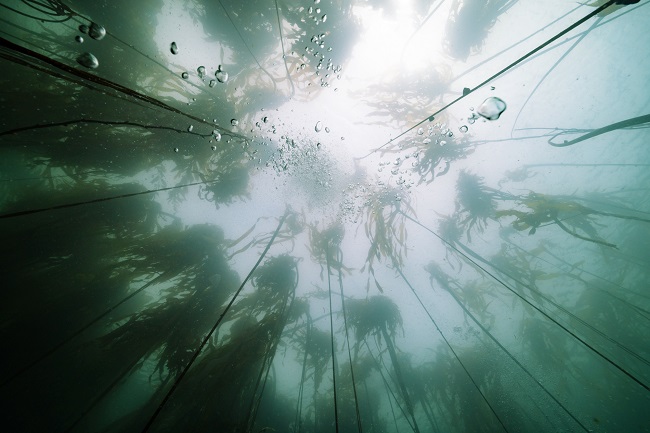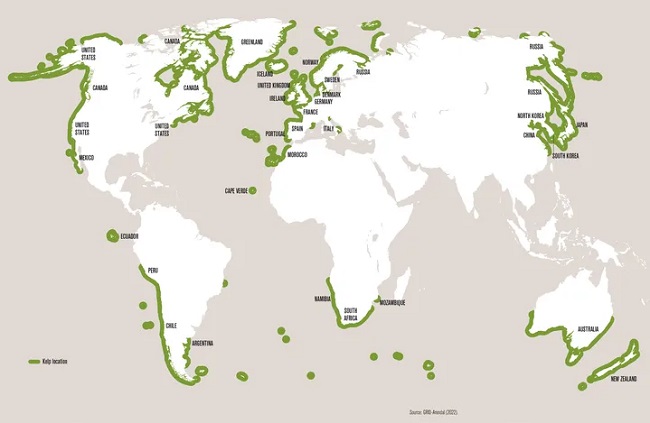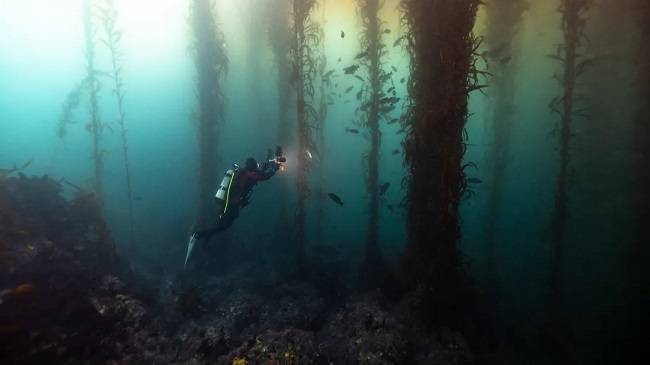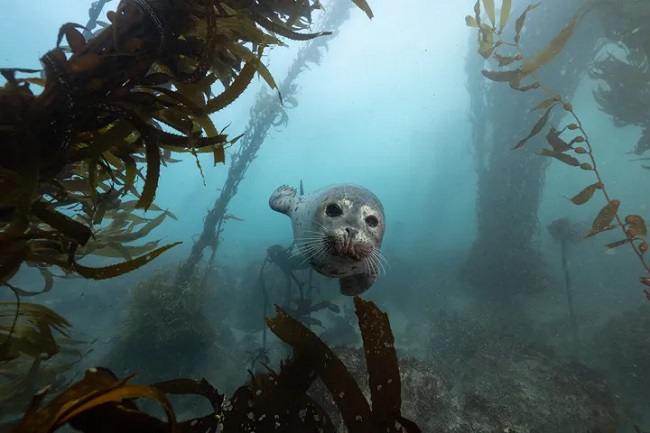Kelp forests arose on the floor of the Pacific Ocean at least 32 million years ago, not 14-15 million years ago as previously thought. This calls into question the prevailing ideas about the evolution of their inhabitants, the press service of the University of California at Berkeley reported. Researchers have found that these important oceanic ecosystems appeared in the Pacific Ocean at the beginning of the Oligocene era, over 32 million years ago. The largest kelp forests are found in cold seas (Arctic Ocean, North Atlantic Ocean, Nordic Seas), but in 2007 kelp forests were also discovered in tropical waters near Ecuador.
Scientists came to this conclusion during excavations in the western regions of the North American state of Washington, where rocks that formed on the bottom of the Pacific Ocean in the distant past occur. In these rocks, scientists discovered many remains of rhizoids, analogues of the root system of kelp algae, imprints of their stems, as well as other evidence that at the beginning of the Oligocene the western shores of the modern United States were covered with algae forests. This, as scientists note, pushes the time of their appearance almost 18 million years ago into the past, since before that the age of the oldest fossil evidence of their existence was 14 million years.
Scientists suggest that ancient kelp forests served as prime habitat for the mysterious Desmostylians, large marine mammals similar in size and appearance to hippopotamuses. They lived off the coast of the Pacific Ocean from the beginning of the Oligocene to the end of the Miocene era, and until now paleontologists could not say in which ecosystems these creatures lived. Their extinction about 7 million years ago made room for modern kelp forest fauna, the researchers concluded.
“We all know that everything fossilizes—large vertebrates, dinosaurs, creatures with bones and hard parts. But algae are a very mobile organism. In addition, they rot quickly because they are eaten by microbes and various animals. Kelp is extremely edible, nutritious and soft. All this results in very few algae being recorded in the fossil record,” said Ceridwin Fraser, a marine scientist at the University of Otago in New Zealand.
For millions of years, the kelp ecosystem was quite simple: the kelp itself was small, perhaps a few meters in height. Then, about 14 million years ago, much taller algae appeared, forming the underwater forests we know today.

Kelp forests have many similarities to their terrestrial counterparts. They form three-dimensional structures that serve as homes for animals. They often have a canopy. And the kelp stems themselves are a bit like trees: they have root-like anchors, a central trunk-like structure, and leaf-like blades. However, there are a few key differences. For example, kelp is not a plant, but a kind of algae, a group of aquatic organisms in a completely different kingdom of life (for them, home is like pond scum and red tide in Florida). They also grow much faster than trees—up to two feet per day, depending on the species.
Kelp forests are commonly found in arctic and temperate waters around the world. The main species of kelp are found in the Atlantic Ocean and on the coasts of China and Japan. The species Ecklonia is found on the coasts of New Zealand, Australia and Africa, while Macrocystis grows in the Pacific Ocean, the Southern Ocean archipelagos and parts of Australia. Due to their complex and sensitive structure, kelp is not common in tropical waters, but kelp has been found in the deep waters of tropical regions such as the Galapagos Islands. The lack of kelp forests in tropical regions is a lack of nutrients in warm, oligotrophic waters.

Laminaria is the term used to refer to seaweeds that are classified as heterocontophytes. It is not taxonomically diverse, but is structurally and functionally diverse. The three main groups of algae differ in appearance, with canopy algae consisting of floating canopies that extend to the surface of the ocean, stem algae, which extend several meters above the seafloor and can grow in dense clumps, and prostrate algae, which lie close to the seafloor.
Although kelp resembles trees, it is a large brown algae that belongs to the protist kingdom. They grow from the bottom of the ocean. Instead of roots like trees, kelp trees have anchors called “anchors” that cling to the rocky substrate on the seafloor. From the shelter, kelp grows towards the surface of the water, with giant kelp growing continuously while the bull completes its growth cycle throughout the year.

From the attachment extend legs that resemble the stems of real plants and extend vertically, providing support for other morphological features of the kelp. They possess leaves, which are leaf-like attachments that extend from the stripe, in some cases the entire length, and are sites of nutrient absorption and photosynthesis. Kelps have gas bubbles (pneumocysts) located at the base of the leaves and near the stipe to provide the necessary buoyancy to keep the upper parts of the kelp afloat.
Kelps go through two stages in their life cycle, where they first exist as spores released by the parent kelps in the earliest stages of their development. The spores develop into tiny male and female gametophytes that produce either eggs or sperm depending on their sex. After fertilization, the embryos develop into mature plants, completing their life cycle. Giant kelp live up to 20 years in their optimal conditions and achieve a growth rate of 10 inches to 2 feet per day, while brown kelp is an annual and grows 4 inches per day.

Kelp forests thrive in cold, nutrient-rich waters along rocky shorelines where depths range from 6 to 90 feet. Kelp growth is facilitated by clean water where sunlight can reach the ocean floor, where kelp life begins. Kelp generally thrives most successfully in regions where ocean waters turn over, bringing cool, nutrient-rich water from the bottom to the surface, and in regions where nutrient-rich waters are constantly available.
In warm waters where temperatures exceed 72 degrees Fahrenheit, kelp does not grow because the amount of dissolved inorganic nitrogen that supports kelp growth is greatly reduced. This phenomenon is especially evident in southern California, where giant kelp forests are destroyed during the summer.
The kelp forests are home to many species of fish, including black and blue grouper and grouper, which are widely sought after by fishermen around the world. Marine mammals, including sea lions, seals and whales, live in kelp forests for protection from predators such as the predatory killer whale.
A symbiotic relationship exists between the inhabitants of kelp ecosystems, where large mammals feed on invertebrates that feed on the kelp. Gray whales feed on crustaceans, while sea otters feed on sea urchins, which could destroy an entire kelp forest if left to breed freely. Bat rays are also common along the Pacific coastline.
Kelp forests are home to a variety of birds, including warblers, crows and starlings, which feed on fly larvae and small crustaceans. Gulls, great blue herons, and terns dominate these ecosystems and are often seen feeding on a variety of fish species and invertebrates living in the seagrass.
In addition to being rich biodiversity ecosystems that support marine life, kelp forests play a fundamental role in supporting water-based recreational activities such as kayaking and snorkeling as they provide protection from rough ocean waters. In ancient times, kelp forests played a huge role for colonizers because they could travel thousands of miles without having to adapt to new ecosystems. In modern economies, people continue to harvest seaweed to feed aquaculture species, as well as extract alginic acid used in anti-inflammatory drugs and toothpaste.
Human activities related to the disposal of untreated waste and coastal runoff contribute to the degradation of kelp forests. Sediment carried by coastal runoff buries most of the roots, while toxic products reduce water quality, thereby affecting the growth of kelp forests.
Invasive opal-eye (crescent-moon) fish species that live in large schools cause damage to algae, especially in areas where they are exposed to adverse environmental conditions. Fishing close to shore releases herbivores from their habitat into kelp forests, where they feed excessively on the kelp and other algae that support these ecosystems. Overfishing has become the main cause of the disappearance of seagrass along the Tasmanian coast.
A desirable resident of the kelp forest is the sea otter, a sea otter. Without sea otters, the kelp forest can turn into a large clearing full of seaweed “stumps.” And all because the sea otter prefers to feed on the main pest of the underwater forest – sea urchins. After them, the complex ecosystem is very quickly replaced by a gnawed wasteland, where only a continuous carpet of prickly balls is visible.




